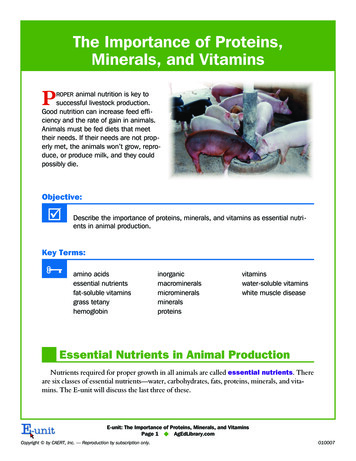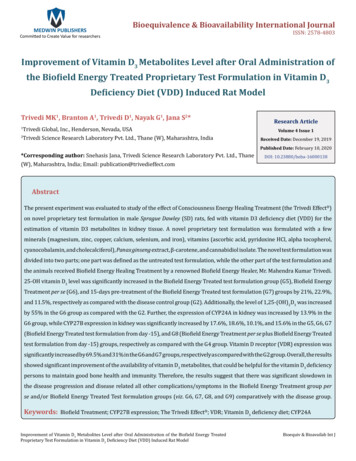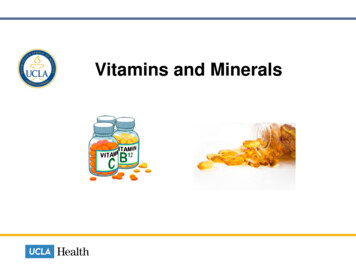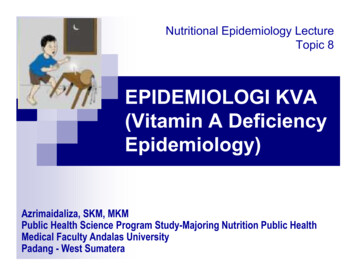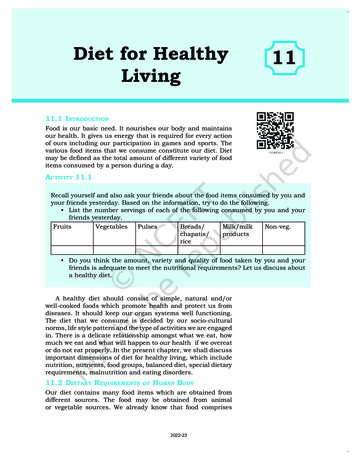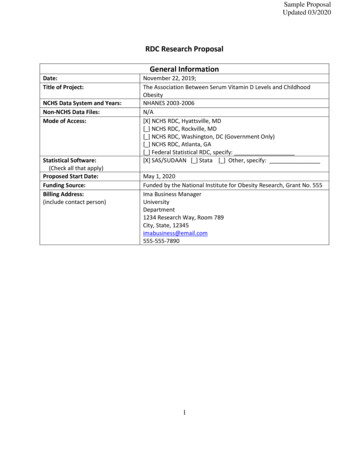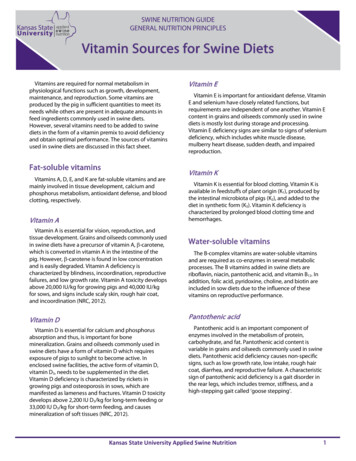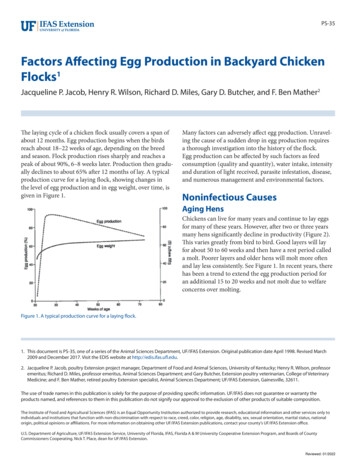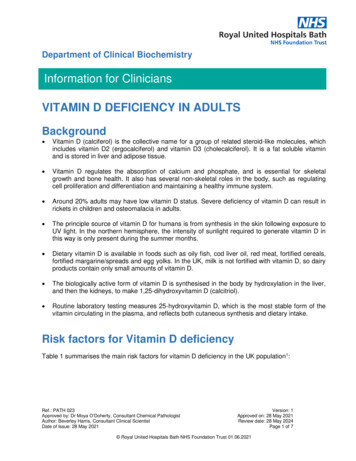
Transcription
Department of Clinical BiochemistryInformation for CliniciansVITAMIN D DEFICIENCY IN ADULTSTSBackground Vitamin D (calciferol) is the collective name for a group of related steroid-like molecules, whichincludes vitamin D2 (ergocalciferol) and vitamin D3 (cholecalciferol). It is a fat soluble vitaminand is stored in liver and adipose tissue. Vitamin D regulates the absorption of calcium and phosphate, and is essential for skeletalgrowth and bone health. It also has several non-skeletal roles in the body, such as regulatingcell proliferation and differentiation and maintaining a healthy immune system. Around 20% adults may have low vitamin D status. Severe deficiency of vitamin D can result inrickets in children and osteomalacia in adults. The principle source of vitamin D for humans is from synthesis in the skin following exposure toUV light. In the northern hemisphere, the intensity of sunlight required to generate vitamin D inthis way is only present during the summer months. Dietary vitamin D is available in foods such as oily fish, cod liver oil, red meat, fortified cereals,fortified margarine/spreads and egg yolks. In the UK, milk is not fortified with vitamin D, so dairyproducts contain only small amounts of vitamin D. The biologically active form of vitamin D is synthesised in the body by hydroxylation in the liver,and then the kidneys, to make 1,25-dihydroxyvitamin D (calcitriol). Routine laboratory testing measures 25-hydroxyvitamin D, which is the most stable form of thevitamin circulating in the plasma, and reflects both cutaneous synthesis and dietary intake.Risk factors for Vitamin D deficiencyTable 1 summarises the main risk factors for vitamin D deficiency in the UK population1:Ref.: PATH 023Approved by: Dr Moya O’Doherty, Consultant Chemical PathologistAuthor: Beverley Harris, Consultant Clinical ScientistDate of Issue: 28 May 2021Version: 1Approved on: 28 May 2021Review date: 28 May 2024Page 1 of 7 Royal United Hospitals Bath NHS Foundation Trust 01.06.2021
Table 1: Risk factors for Vitamin D deficiencyInadequate UVB lightInadequate dietaryMetabolic factorsexposureintake or absorptionPigmented skin (non-whiteVegetarian/vegan (or other People aged 65 years (reduced synthesisethnicity)fish-free diet)in the skin)Lack of sunlight exposure oratmospheric pollutionLatitudeSkin concealing garments orroutine use of sun protectionfactor 15 or aboveMalabsorption (e.g.coeliac disease, cysticfibrosis, Crohn’s diseaseetc.)Short bowel syndromeCholestatic liver disease,jaundicePregnant/breastfeeding womenDrug interactions, e.g. rifampicin,anticonvulsants (carbamazepine,oxcarbazepine, phenobarbital, phenytoin,primidone, valproate), isoniazid,cholestyramine, sucralfate, glucocorticoids,highly active antiretroviral treatment(HAART)Housebound or indoor living(e.g. care homes)Chronic liver diseaseSeasonalChronic kidney diseaseNephrotic syndromePrevention of Vitamin D deficiency/insufficiencyThe Scientific Advisory Committee on Nutrition (SACN) report on Vitamin D and Health2 and NICEClinical Knowledge Summary (2018)3 recommend the following for the UK population to preventvitamin D deficiency/insufficiency: People in higher risk groups (see Table 1) are advised to take a daily supplement of400 IU (10 µg) vitamin D throughout the year. In winter months (October to early March), ALL adults (and children 4 years old) shouldconsider taking a daily supplement of 400 IU (10 µg) vitamin D In summer months, the majority of the population will get enough vitamin D throughexposure to sunlight and a healthy, balanced diet.NOTE: Supplements are widely available as over the counter preparations and SHOULD NOTbe prescribed.Ref.: PATH 023Approved by: Dr Moya O’Doherty, Consultant Chemical PathologistAuthor: Beverley Harris, Consultant Clinical ScientistDate of Issue: 28 May 2021Version: 1Approved on: 28 May 2021Review date: 28 May 2024Page 2 of 7 Royal United Hospitals Bath NHS Foundation Trust 01.06.2021
Vitamin D and COVID-19In December 2020, in response to the global pandemic, NICE published a rapid guideline4 on theuse of vitamin D supplements to either prevent or treat COVID-19. While acknowledging there isinsufficient evidence at present to advocate use of supplements for this purpose, the panel stronglyreiterated current UK government advice regarding year round supplementation in high risk groupsand in the whole population over the age of 4 years old during the winter months. This is consideredto be particularly important during the pandemic because people have been confined indoors morethan usual during the spring and summer months5.Vitamin D supplements should not be offered solely to prevent or treat COVID-19, except as part ofa clinical trial.When should vitamin D be measured?Routine testing for vitamin D deficiency is NOT necessary.Vitamin D (25-hydroxyvitamin D) measurement is only indicated: for patients with diseases with outcomes that may be improved with vitamin D treatment, e.g.confirmed osteomalacia, osteoporosis. (NB: measurement is not necessary if patient is coprescribed vitamin D with their anti-resorptive treatment) for patients with symptoms that could be attributed to vitamin D deficiency, e.g. suspectedosteomalacia, chronic widespread pain with other features of osteomalacia before starting patients on a potent antiresorptive agent (zoledronate, denosumab,teripardatide)6.See Figure 1 for a summary of the guidance from the Royal Osteoporosis Society (Vitamin D andBone Health: a practical clinical guideline for patient management, 2018).6Ref.: PATH 023Approved by: Dr Moya O’Doherty, Consultant Chemical PathologistAuthor: Beverley Harris, Consultant Clinical ScientistDate of Issue: 28 May 2021Version: 1Approved on: 28 May 2021Review date: 28 May 2024Page 3 of 7 Royal United Hospitals Bath NHS Foundation Trust 01.06.2021
Figure 1: When should vitamin D be measured?No risk factors fordeficiency,symptom freeRisk factors* fordeficiency,symptom freeSymptoms# that couldbe attributed tovitamin D deficiency,e.g. suspectedosteomalacia, chronicwidespread painKnown diseasewhere vitamin Dtreatment improvesoutcomes,e.g. confirmedosteomalaciaStarting antiresorptive agent,e.g. zoledronate,denousmab,teriparatideDO NOT MEASURE VITAMIN DCHECK VITAMIN D STATUSOffer lifestyle and long-term preventative adviceOffer lifestyle and long-term preventative adviceFor high risk groups*: year roundsupplementation is strongly advisedusing OTC supplementsTherapeutic intervention may be required: see Table 3 and Figure 2*Risk factors, e.g. lack of sunlight exposure, darker skin, housebound, malabsorption, pregnant/breastfeeding (see Table 1 for fulldetails)#Symptoms can include muscle aches and weakness, especially in quadriceps and glutei, waddling gait, chronic widespread pain orbone pain in lower back, pelvis and foot.Ref.: PATH 023Approved by: Dr Moya O’Doherty, Consultant Chemical PathologistAuthor: Beverley Harris, Consultant Clinical ScientistDate of Issue: 28 May 2021Version: 1Approved on: 28 May 2021Review date: 28 May 2024Page 4 of 7 Royal United Hospitals Bath NHS Foundation Trust 01.06.2021
Interpretation of vitamin D resultsThe Royal Osteoporosis Society guideline6, Vitamin D and Bone Health: a practical clinical guidelinefor patient management, recommends the following interpretation of vitamin D results with respect tobone health (see Table 3).Table 3: Interpretation of vitamin D resultsVitamin DVitamin D statusconcentration 25 nmol/LDeficient25-50 nmol/LMay be inadequate forsome people 50 nmol/LAdequate: sufficient forbone health in most peopleManagementHigh dose cholecalciferol, then maintenance treatmentFurther investigations generally not required, but maybe helpful to identify treatable causes of vitamin DdeficiencyReview modifiable risk factorsLifestyle advice.Maintenance vitamin D supplementsLifestyle advice, including supplements as advised forgeneral populationFurther investigationsThe major causes of vitamin D deficiency are lack of sun exposure and/or poor dietary intake.Further investigations are therefore generally NOT required.Other common causes are malabsorption and underlying disease such as kidney or liverdysfunction, for which specific investigations may be appropriate. These could include FBC,U&E/eGFR, LFTs, calcium/phosphate, PTH (if hypercalcaemic). However, these tests are notroutinely indicated in vitamin D deficiency.For further advice about individual patients, please contact the duty biochemist to discussappropriate investigations (tel: 01225 824050).Management A summary of the BSW CCG treatment guidelines for vitamin D deficiency is shown in Figure2. For more detailed information, please refer to the full guideline.7 If there is severe vitamin D deficiency ( 25 nmol/L), a treatment (loading) dose followed bylong-term maintenance vitamin D is recommended (maintenance vitamin D should be overthe counter medication and not prescribed) If serum vitamin D is between 25-50 nmol/L, treatment may be indicated if high risk.Ref.: PATH 023Approved by: Dr Moya O’Doherty, Consultant Chemical PathologistAuthor: Beverley Harris, Consultant Clinical ScientistDate of Issue: 28 May 2021Version: 1Approved on: 28 May 2021Review date: 28 May 2024Page 5 of 7 Royal United Hospitals Bath NHS Foundation Trust 01.06.2021
If serum vitamin D is 50 nmol/L, vitamin D replacement is NOT necessary, unless there arespecific clinical indications. Routine monitoring of serum vitamin D is usually unnecessary; it may be appropriate inpatients with symptomatic vitamin D deficiency, malabsorption, or if poor compliance issuspected. Whilst on maintenance dose, re-check bone profile and vitamin D if there are symptomssuggestive of vitamin D toxicosis or hypercalcaemia (confusion, polyuria, polydipsia, anorexia,vomiting, constipation or muscle weakness). If taking potent anti-resorptive agents (e.g. zoledronate, denosumab, teriparatide), checkvitamin D before starting treatment, then annually (to prevent hypocalcaemia developing).References1.Nottinghamshire Area Prescribing Committee: Vitamin D Management in Adults in-d-guidelines-adults.pdf (accessed 21.05.21)2.Scientific Advisory Committee on Nutrition: Vitamin D and Health ernment/uploads/system/uploads/attachment data/file/537616/SACN Vitamin D and Health report.pdf (accessed 21.05.21)3.NICE Clinical Knowledge Summary (last revised December 2020): Vitamin D deficiency inadults – treatment and -deficiency-in-adults-treatment-prevention/ (accessed21.05.21)4.NICE guideline 187: COVID-19 rapid guideline: vitamin D 720709 (accessed 24.05.21)5.Vitamin D supplementation during winter (November 2020): PHE and NICE statementStatement from PHE and NICE on vitamin D supplementation during winter - GOV.UK (www.gov.uk)(accessed 24.05.21)6.Royal Osteoporosis Society 2018: Vitamin D and Bone Health: a practical clinical guidelinefor patient management ebruary-2020.pdf (accessed 21.05.21)7.BSW CCG Treatment of Vitamin D deficiency in adults (March .asp?FormularySectionID 9&SubSectionRef 09.06.04&SubSectionID A100 (accessed 21.05.21)Ref.: PATH 023Approved by: Dr Moya O’Doherty, Consultant Chemical PathologistAuthor: Beverley Harris, Consultant Clinical ScientistDate of Issue: 28 May 2021Version: 1Approved on: 28 May 2021Review date: 28 May 2024Page 6 of 7 Royal United Hospitals Bath NHS Foundation Trust 01.06.2021
Figure 2: Treatment guidelines for vitamin D deficiency7 (BSW CCG March 2021)25-OH vitamin D result (nmol/L)25-50May be inadequate forsome people 25Deficient 50Adequate:Sufficient for bonehealth in most peopleReview risk factors (see Table 1):treatment only recommended if highrisk, or previous fragilityfracture/osteoporosisClinical review andconsider furtherinvestigations if indicatedTarget for replacement 300,000 IUTarget for replacement 150,000 IUTreatment dose:50,000 IU per week for 6 weekse.g. InVita D3 oral solution (25,000IU/amp) 2 ampoules per week ORStexerol D3 (25,000 IU/tablet) 2tablets per weekTreatment dose:25,000 IU per week for 6 weekse.g. InVita D3 oral solution (25,000IU/amp) 1 ampoule per week ORStexerol D3 (25,000 IU/tablet) 1 tabletper weekFollowed byMaintenance dose: 25,000 IU per monthEncourage patients to buy OTC, e.g.800-2000 IU daily tabletsFollowed byMaintenance dose: 25,000 IU per monthEncourage patients to buy OTC, e.g.800-2000 IU daily tabletsLifestyle advice,including use ofsupplements asrecommended forthe generalpopulationCheck adjusted calcium one month after startingvitamin D replacementRef.: PATH 023Approved by: Dr Moya O’Doherty, Consultant Chemical PathologistAuthor: Beverley Harris, Consultant Clinical ScientistDate of Issue: 28 May 2021Version: 1Approved on: 28 May 2021Review date: 28 May 2024Page 7 of 7 Royal United Hospitals Bath NHS Foundation Trust 01.06.2021
cell proliferation and differentiation and maintaining a healthy immune system. Around 20% adults may have low vitamin D status. Severe deficiency of vitamin D can result in . Latitude Skin concealing garments or routine use of sun protection . for patient management, recommends the following interpretation of vitamin D results with respect to


